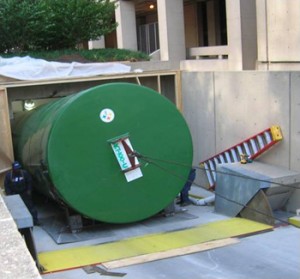Over the course of the next few blogs, we’re going to do a brief series on water and storage tanks. Water is a threat not just to a storage tank, but to the storage tank’s related system components as well. Water in a tank system can cause a number of problems, including contamination of fuel, degradation of components, bacteria growth, and corrosion leading to a leak. Fortunately, there are means of monitoring tanks for the presence of water and removing water when it’s detected. There are also means of preventing water from getting into a storage tank in the first place.
We’ll cover both of these topics in the next blogs in our storage tanks and water series. But this week, we’re going to focus on how water gets into a storage tank/tank system in the first place.

How does water get into a storage tank system?
There are a number of ways by which water can enter a storage tank system.
- Water captured in the spill bucket can accidentally be drained into the tank.
- Condensation, which is caused as a result of fuel temperature swings or air entering the vents. This is more prevalent in aboveground tanks.
- Loose plugs, fittings.
- A damaged spill bucket or fill cap gaskets.
- “High throughput in the fuel distribution/delivery infrastructure, allowing less time for water to settle out of the product before it’s pumped at the refinery or as it’s moved along the shipping process.” This is becoming more of an issue, as delivery infrastructures are increasingly shared among distributors, which reduces the level of quality control that anyone distributor has. The end result is that more water is being left in the product, which is then delivered to the tank.
- The chemical makeup of the fuel itself may attract moisture. ULSD, for example, is known to attract water. “Generally, the high in aromatic content and the warmer the fuel, the more water it can hold in solution,” according to STI. “That’s usually not a problem until the fuel is cooled, causing the water to be released and settle at the bottom of a storage tank.”